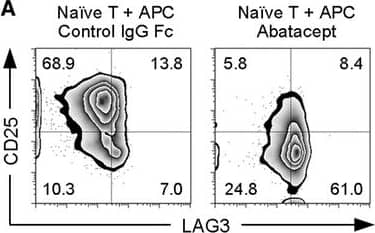Human LAG-3 PE-conjugated Antibody
R&D Systems, part of Bio-Techne | Catalog # FAB2319P

Key Product Details
Validated by
Species Reactivity
Validated:
Cited:
Applications
Validated:
Cited:
Label
Antibody Source
Product Specifications
Immunogen
Leu23-Leu450
Accession # P18627
Specificity
Clonality
Host
Isotype
Scientific Data Images for Human LAG-3 PE-conjugated Antibody
Detection of LAG-3 in HEK293 Human Cell Line Transfected with Human LAG-3 and eGFP by Flow Cytometry.
HEK293 human embryonic kidney cell line transfected with either (A) human LAG-3 or (B) irrelevant transfectants and eGFP was stained with Goat Anti-Human LAG-3 Phycoerythrin-conjugated Antigen Affinity-purified Polyclonal Antibody (Catalog # FAB2319P). Quadrant markers were set based on control antibody staining (Catalog # IC108P, data not shown). View our protocol for Staining Membrane-associated Proteins.Detection of LAG-3 in Human PBMCs by Flow Cytometry.
CD3+ PHA-treated peripheral blood mononuclear cells (PBMCs) were stained with Mouse Anti-Human CD3e APC-conjugated Monoclonal Antibody (Catalog # FAB100A) and either (A) Goat Anti-Human LAG-3 PE-conjugated Antigen Affinity-purified Polyclonal Antibody (Catalog # FAB2319P) or (B) Normal Goat IgG Phycoerythrin Control (Catalog # IC108P). View our protocol for Staining Membrane-associated Proteins.Detection of Human LAG-3 by Flow Cytometry
Human CD4+CD25−LAG3+ T cells suppressed antibody production. a Gating strategy of fluorescence-activated cell sorting analysis for CD4+CD25−LAG3+CD45RA− T cells (LAG3+ Tregs) and CD4+CD25+CD127dimCD45RA− T cells (CD25+ Tregs). b IL-10, IFN-gamma, and IL-17A protein levels in the culture supernatants after 3 days of incubation of the indicated T-cell subsets was determined by ELISA (n = 6). c B cells and TFH cells were cocultured with the indicated subsets for 12 days in the presence of SEB stimulation, and total IgG, IgM, and IgA production was determined by ELISA (n = 6). d B cells and TFH cells were cocultured with CD4+CD25−LAG3+CD49b− T cells for 12 days in the presence of SEB stimulation, and total IgG was determined by ELISA (n = 3). All error bars represent SD. * P < 0.05; ** P < 0.01; *** P < 0.001; **** P < 0.0001. All P values were calculated by one-way analysis of variance and Tukey’s multiple-comparisons test. CD Cluster of differentiation, ELISA Enzyme-linked immunosorbent assay, IFN-gamma Interferon-gamma, Ig Immunoglobulin, IL Interleukin, LAG3 Lymphocyte activation gene 3, RA Rheumatoid arthritis, SEB Staphylococcal enterotoxin B, TFH Follicular helper T cell, Treg Regulatory T cell Image collected and cropped by CiteAb from the following publication (https://arthritis-research.biomedcentral.com/articles/10.1186/s13075-017-1309-x), licensed under a CC-BY license. Not internally tested by R&D Systems.Applications for Human LAG-3 PE-conjugated Antibody
Flow Cytometry
Sample: Human peripheral blood mononuclear cells (PBMCs) treated with PHA and HEK293 Human Cell Line Transfected with Human LAG-3 and eGFP
Formulation, Preparation, and Storage
Purification
Formulation
Shipping
Stability & Storage
- 12 months from date of receipt, 2 to 8 °C as supplied.
Background: LAG-3
LAG-3 is an activation-induced molecule, expressed on activated T cells and NK cells, but not on resting T cells. Studies using LAG-3 -/- mice have shown significant delay of T cell apoptosis following antigen stimulation and increased size of memory T cells pool following infection (3, 4). It also has been reported that anti-LAG-3 antibodies up-regulate T cell activation by blocking interaction of LAG-3 and MHC class II. The study has demonstrated that LAG-3 is selectively expressed on activated CD4+CD25+ TReg cells and plays a role in their suppressive activity (5). This evidence indicated, unlike the interaction of CD4 with MHC class II that plays a positive role in T cell activation, LAG-3 binds to MHC class II and negatively regulates T cell activation through LAG-3 signaling. On the other hand, studies have shown that binding of LAG-3 to MHC class II molecules on antigen presenting cells induce maturation of dendritic cells and cytokine secretion by monocytes through MHC class II signal transduction (6). Taken together, LAG-3 may have two major functions, it negatively regulates T cells activation through LAG-3 signaling and stimulates antigen presenting cells which express MHC class II.
References
- Triebel, F. et al. (1990) J. Exp. Med. 171:1393.
- Baixeras, E. et al. (1992) J. Exp. Med 176:327.
- Workman, C.J. and D.A. Vignali (2003) Eur. J. Immunol. 33:970.
- Workman, C.J. et al. (2004) J. Immunol. 172:5450.
- Huang, C.T. et al. (2004) Immunity 21:503.
- Andreae, S. et al. (2003) Blood 102:2130.
Long Name
Alternate Names
Gene Symbol
UniProt
Additional LAG-3 Products
Product Documents for Human LAG-3 PE-conjugated Antibody
Product Specific Notices for Human LAG-3 PE-conjugated Antibody
For research use only



